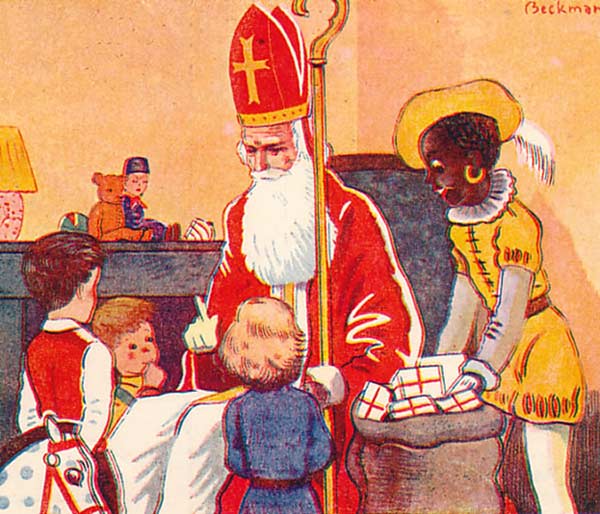I will forever need a nightlight. I peek in the shower before using the bathroom. I flinch at loud noises. And, at the achy old age of 36, I’m afraid to be home alone.
Other than the occasional locked-in-the-basement prank from my brother, I see no other reason for these fears than St. Nicholas himself.
Sure, he’s the patron saint of sailors, brewers, prostitutes, brides, grooms, the hungry, and a million other groups—and he’s known as the Protector of Children and the ultimate gift giver. But he’s also associated with the eeriest evening of the year: St. Nick Night.
Thankfully, it also happens to be the most magical and anticipated evening of the year. Growing up, I didn’t know anyone who celebrated it aside from my brother and I, our 24 first cousins, and the associated adults; therefore, I knew we were the coolest kids around. I reveled in saying, “Today’s a holiday in my family,” as if the Paiges had invented it, and went on to explain the festivities like I couldn’t be bothered.
The Man, The Saint, The Legend
Nicholas, whose last name I have yet to come across, was born in modern-day Turkey around the year 280. His parents died when he was young and bequeathed him a sizeable inheritance. Rather than blow the dough on a Power Wheels Barbie Jeep like I would have, he used it to help the needy.
One common story strengthens the legend: An impoverished man with three daughters was on the verge of selling them into slavery (or prostitution, depending on the source) because he was too poor to pay dowries for prospective husbands. On three separate occasions, Nicholas tossed a bag of gold in the man’s window (or was it down the chimney?), and the women were saved from a life of servitude.
Legend has it, when the good man was tossing gold into the house, the contents landed in stockings or shoes that were left by the fire to dry, which evolved into the custom of children hanging stockings or putting out shoes for St. Nicholas to fill with gifts. (The story is occasionally told as three gold balls tossed in the window, which are represented by oranges).
He also allegedly saved men who were falsely imprisoned and sentenced to death, and restored the bodies (and lives) of young children who were slain and sliced and left in a pickling tub. Whether these are authentic happenings or simply loose retellings, Nicholas has forever been associated with goodness and generosity. He became a bishop at a young age and was later named a saint. What. A. Showoff.
The Original Buddy System?

St. Nicholas is believed to have died on December 6, 343, which is a ridiculously long time ago for people to still be talking about him. This date, however, became a day of celebration: St. Nicholas Day.* And, to carry on his stories, many European countries formed their own interpretations of the myth, with some crossover:
- In Germany and Poland, boys dressed as bishops beg for donations for the poor.
- In the Netherlands and Belgium, St. Nick arrives on a ship from Spain and rides a white horse while making his rounds.
- Occasionally, he travels by white horse in Germany and Poland as well.
- Hoping to persuade the old man to leave them gifts, Dutch children stuff their shoes with carrots and hay for the white horse.
- In France, Belgium, Luxembourg, and Switzerland, a donkey carries St. Nicholas and baskets of treats and toys.
- In the Netherlands, St. Nicholas is celebrated on the eve of his day, by sharing candies, small gifts, and riddles.
And, in many versions of the holiday, St. Nick doesn’t fly solo:
- In upstanding areas of Belgium, Germany, Poland, Ukraine, and Austria, St. Nicholas is accompanied by angels (let it be known, this is the first I’m hearing of angels).
- On the other hand, in Czech and Slovak traditions, a creepy-ass devil equipped with horns, a tail, and a long red tongue rides shotgun. He comes with a staff to threaten punishment, but he’s usually chained up, so the kids should be fine.
- In Germany, there are many sidekicks depending on the region, but the most notable is Ruprecht, or Knecht Ruprecht, an intimidating, frightening figure meant to scare children into good behavior. His face is sooty from traveling via chimney to give coal and switches to naughty children.
- In areas of France, Hanstrapp or Rupelz shows up and pulls the same moves as Ruprecht.
- In the Netherlands and areas of Belgium, Zwarte Piet (a Moor from Africa), or Black Peter, comes with St. Nick. He listens down chimneys to monitor children’s behavior before delivering gifts.
- In Austria, there’s Krampus, a half-goat, half-demon, horrific beast who tags along to beat (or eat) the bad broods.
*Wondering how St. Nicholas and his day morphed into Santa Claus and Christmas? Here’s National Geographic’s account.
Our Family Inheritance
Perhaps it’s because early Americans bastardized the true legend of the saint or because none of us has an updated Ancestry.com account, but our family’s version of St. Nicholas Day is a mashup of each of these traditions. There’s also, presumably, a touch of Schlitz-inspired, Paige clan poppycock.
For starters, we celebrate on the evening of the 5th and we call it St. Nick Night.
We gather in one cozy living room—the breakables displaced and the beer within arm’s reach—and stumble through Christmas carols. Sure, some of us sing confidently in tune, but most of us are tone deaf and hum along as we wonder how the hell anyone can remember every verse of “I’m Gettin’ Nuttin’ For Christmas.”
Usually, somewhere around the “click, click, click” of “Up on the House Top,” I think now would be a perfect time for him to show up. But then someone launches into the ever-inappropriate “Santa Baby” and we remain on the edge of our seats.
One by one, we fire off good deeds we performed that day, so that St. Nick knows we’ve been good. The day before doesn’t count—even if you drove Gram to church. It has to be that day. If you’re obviously fibbing or struggling to come up with something, you instantly become the last person anyone wants to be around. Krampus’s switch has some serious reach.
Usually during our good deeds, St. Nick and his helper announce their arrival with a pound on the house. For the next 15 minutes or so, windows rattle from the tap of hands and bells; doors open and slam, catapulting Christmas wreaths; walls tremble from the banging. We pull blankets tight to our necks and hide behind each other as we blurt out, “We love you, St. Nick!,” attempt to get through more songs, and berate those who haven’t yet shared their good deeds, raising our normal outrageous family-party volume to decibels unknown.
Sometimes, our visitors can be heard upstairs, which you might think sounds silly but is actually just about the scariest shit of all time. Especially if the festivities are being held at your house.
When the knocking dies down and minutes have passed since the last bells have been jingled, someone inevitably assumes we must’ve been bad and we’ll go without goodies this year. But finally, a sack is tossed in through a window or door and the children, good or bad, race toward it. Out pours oranges, peanuts, cookies, candy canes, and almost always lumps of coal. Sometimes we’re left to fight over who the coal is meant for, and other times St. Nick graciously assigns it himself.

Aside from the edible goodies, we sometimes receive other trinkets like cups or pencils; one year, all the girls even received a dowry. Speaking for my father only, I assure you this was not just a nod to the saint himself and he was, in fact, trying to get rid of me at the age of 9.
After kids peer out the window while “you’re BRAAAVE”s are hurled at them, the next step, naturally, is for Gram and Uncle Larry to take out their dentures and lisp their way through “All I Want For Christmas is My Two Front Teeth,” joined by any child missing a pearly white at that time.
A magical evening, indeed.
We’ve heard the jingle of a tambourine in the distance. We’ve spotted Black Peter’s black glove. We’ve endured a cracked window. We’ve searched for horse tracks in the snow. We’ve defended the tradition against outlaws who playfully dubbed it “Halloween Christmas.” We’ve received a letter calling out the good kids versus the bad. We’ve caught a glimpse of St. Nick walking down the street—a tall miter and hooked staff to distract from the jeans and boots that look a lot like the ones our uncle’s friend might show up in later.
Many years, we’ve been graced with Gram’s quiet rendition of “Silent Night” in German, although none of us would know if she was just bullshitting the words. And we’ve successfully passed down the tradition from generation to generation, from one living room to another.
After the last tunes are caroled and the loot is all claimed, some of the lucky ones go home, put their shoes out, and awake to more treasures and goodies.
Others go home and rush to turn on every light before jumping into bed.













